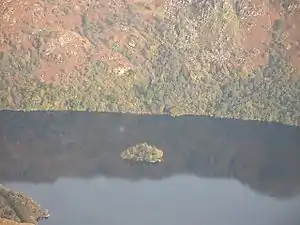Island I Vow
Eilean I Vow is a small island in Loch Lomond in west central Scotland. Other variants of the name include Ellan I Vow, Eilean a' Vow, Elanvow, Ellan Vhow[1] and Island I Vow.[1] The island is listed in 13th/14th century charters as "Elanvow".[2][3][4]

It is opposite Rubha Bàn, a point on the mainland, and north of Inveruglas Isle. It is 10 m at its highest point, and 0.08 km long.
The island was a stronghold of Clan MacFarlane, and there are the remains of their castle on it, which was built to replace the one on Inveruglas Isle.[5] In 1710, Buchanan of Auchmar described it as "a pretty good house with gardens".[5]
The etymology of the name may alternatively represent "Eilean a' Bhuth" (island of the shop or store)[5][6] or "Eilean a' Bhogha" (Island of the Sunken Rock).[7] For more research on the historical names of Island I Vow click here. In 1962, I.M.M. McPhail speculated that the name might derive from Eilean a' Bhò or "Island of the Cow",[8] but Scottish Gaelic experts, including experts at Ainmean-Àite na h-Alba, have indicated that that is not grammatically correct and is not possible.
Island I Vow archaeology and preservation
Island I Vow is protected as a scheduled monument by the Scottish Government under the Ancient Monuments and Archaeological Areas Act 1979. The castle is of national importance for its historical associations with the MacFarlane chiefs and for the potential of its above and below ground archaeology as a representative example of medieval island strongholds.[9] The castle was still inhabited in 1724 but was in ruins by 1814.[9][1] The east and south walls of the castle are in a reasonable state of preservation,[9] but the north wall is mostly collapsed above ground and first floor level.[1] An assessment of the condition of the site in 2012 during low loch levels revealed the presence of a perimeter wall around the entire island.[1]
The Ellan Vhow Preservation Fund (The Elanvow Preservation Fund) has been set up to support archaeological study and preservation of this historic site.[10]
References
- Worsley, Harry Loch Lomond: The Loch, the Lairds and the Legends ISBN 978-1-898169-34-5 Lindsay Publications (Glasgow) 1988
- Historic Environment Scotland. "Island I Vow, Castle (23837)". Canmore. Retrieved 16 April 2019.
- Cartularium Comitatus de Levenax. Maitland Club. 1833. p. 64.
- "Cartalarium Comitatus de Levenax".
- Nisbet, Alexander (1804). A System of Heraldry, Speculative and Practical : with the True Art of Blazon, ..., 2nd ed. v II. Edinburgh: Alexander Lawrie and Company. p. 59.
- "Introduction to Loch Lomond Islands". Callander, Trossachs and Loch Lomond. Archived from the original on 2008-09-21. Retrieved 2008-09-25.
- "Names of the Islands of Lochlomond in Irish and English" (Dated 1701), Analecta Scotica: collections illustrative of the civil, ecclesiastical and literal history of Scotland, James Maidment, 1834, p. 116
- "The illustrated Gaelic-English Dictionary", Edward Dwelly, Birlinn Limited (1993), p 1014
- McPhail, I.M.M. (1962). A Short History of Dumbartonshire. p. 29.
- Historic Environment Scotland. "Island I Vow, castle and settlement, Loch Lomond (SM11073)". Retrieved 16 April 2019.
- The Elanvow Preservation Fund
External links
| Wikimedia Commons has media related to Island I Vow. |
- http://islandivow.org/
- Ellan Vhow Preservation Fund
- The Elanvow Preservation Fund
- https://web.archive.org/web/20120218135111/http://www.incallander.me.uk/loch-lomond.htm
- https://web.archive.org/web/20090710015304/http://lochlomond-islands.com/
- article which mentions it